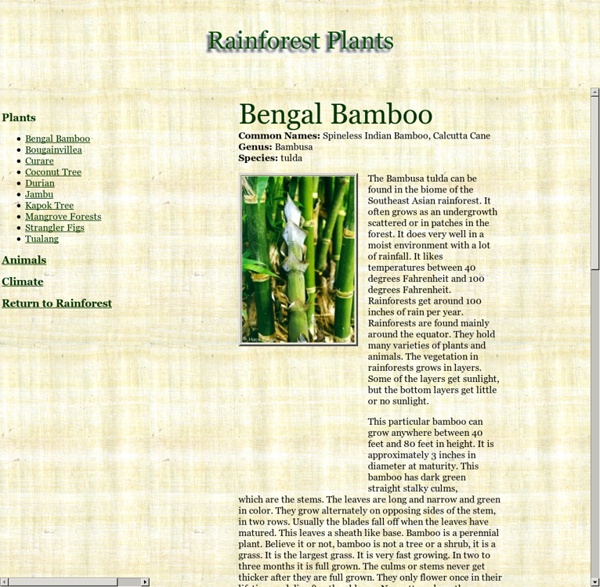



The Plants of the Rainforest A tropical greenhouse More than two thirds of the world's plant species are found in the tropical rainforests: plants that provide shelter and food for rainforest animals as well as taking part in the gas exchanges which provide much of the world's oxygen supply. Rainforest plants live in a warm humid environment that allows an enormous variation rare in more temperate climates: some like the orchids have beautiful flowers adapted to attract the profusion of forest insects. Competition at ground level for light and food has lead to evolution of plants which live on the branches of other plants, or even strangle large trees to fight for survival. The aerial plants often gather nourishment from the air itself using so-called 'air roots';.
Tropical rainforest climate Worldwide zones of Tropical rainforest climate (Af). A tropical rainforest climate, also known as an equatorial climate, is a tropical climate usually (but not always) found along the equator. Regions with this climate typically feature tropical rainforests, and it is designated by the Köppen climate classification. Description[edit] Distribution[edit] Upland rainforest in Borneo. A tropical rainforest climate is usually found at latitudes within five degrees North and south of the equator, which are dominated by the Intertropical Convergence Zone. Some of the places that have this climate are indeed uniformly and monotonously wet throughout the year (e.g., the northwest Pacific coast of South and Central America, from Ecuador to Costa Rica, see for instance, Andagoya, Colombia), but in many cases the period of higher sun and longer days is distinctly driest (as at Palembang, Indonesia) or the time of lower sun and shorter days may have more rain (as at Sitiawan, Malaysia). Examples[edit]
Rainforest Biomes The tropical rain forest is a forest of tall trees in a region of year-round warmth. An average of 50 to 260 inches (125 to 660 cm.) of rain falls yearly. Rain forests belong to the tropical wet climate group. The temperature in a rain forest rarely gets higher than 93 °F (34 °C) or drops below 68 °F (20 °C); average humidity is between 77 and 88%; rainfall is often more than 100 inches a year. There is usually a brief season of less rain. Rainforests now cover less than 6% of Earth's land surface. A tropical rain forest has more kinds of trees than any other area in the world. About 1/4 of all the medicines we use come from rainforest plants. All tropical rain forests resemble one another in some ways. Despite these differences, each of the three largest rainforests--the American, the African, and the Asian--has a different group of animal and plant species. Layers of the Rainforest There are four very distinct layers of trees in a tropical rain forest. Plant Life Animal Life
Rainforests Facts Facts about Rainforests Do you know how many tropical rainforest plants have been identified as having anti-cancer properties? Or how many continents around the world contain rainforests? And just how quickly are the world's rainforests disappearing? Find out the answers to these questions and more as you check out these interesting rainforest facts! Facts about the Global Coverage of Rainforests Covering less than 2 percent of the Earth's total surface area, the world's rainforests are home to 50 percent of the Earth's plants and animals. Facts about the Rainforest as Part of our Global Environment and Well-being Rainforests act as the world's thermostat by regulating temperatures and weather patterns. Facts about the Abundant Life and Important Resources that Rainforests Share with Us A typical four-square-mile patch of rainforest contains as many as 1,500 flowering plants, 750 species of trees, 400 species of birds and 150 species of butterflies. Want to Test Your Rainforest Knowledge?
Rainforest Animals Interesting facts Climate Animals Plants